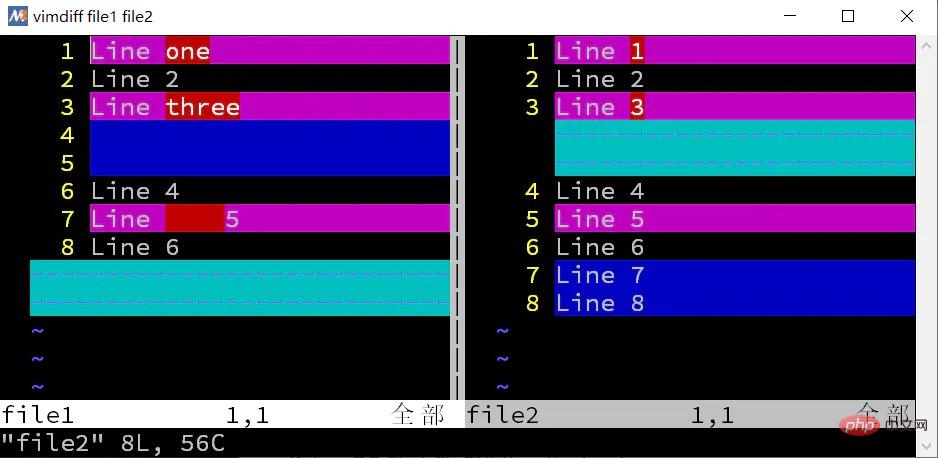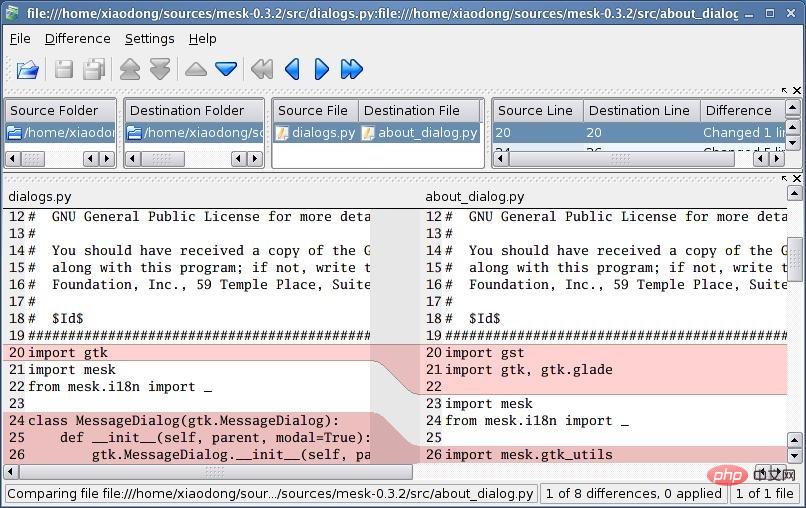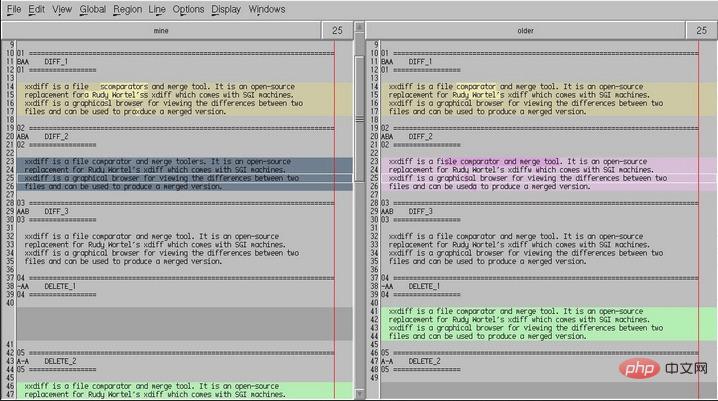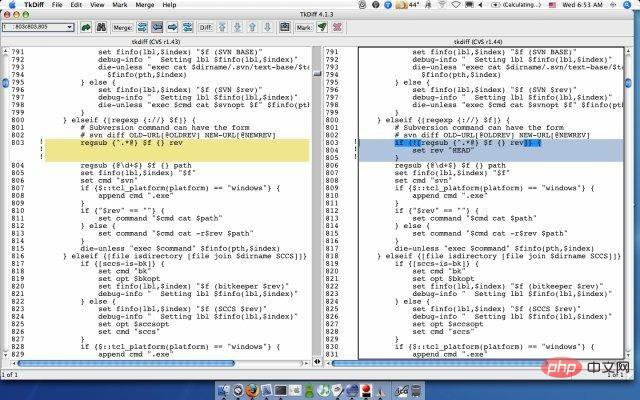 Operation and Maintenance
Operation and Maintenance
 Linux Operation and Maintenance
Linux Operation and Maintenance
 9 excellent code comparison tools under Linux [Recommended]
9 excellent code comparison tools under Linux [Recommended]
9 excellent code comparison tools under Linux [Recommended]
The following column linux tutorial will introduce you to 9 excellent code comparison tools under Linux. I hope it will be helpful to friends in need!
![9 excellent code comparison tools under Linux [Recommended]](https://img.php.cn/upload/article/000/000/020/5ef97f545f01f272.jpg)
When we write code, we often need to know the differences between two files, or between different versions of the same file. There is a very powerful tool called BeyondCompare under Windows. So what tools do you need to use under Linux?
This article introduces 9 commonly used code comparison tools under Linux, including not only command line tools, but also GUI interface tools, allowing you to easily perform code comparisons.
1. diff command
diff command is a powerful text comparison tool that comes with Linux, and it is very convenient to use. Regarding its use, I have written a separate article before. Click the link below to view it.
Teach you a trick on text comparison method under Linux
The diff command is pre-installed in most Linux distributions. It can compare two text files line by line and output Their differences. For more information, you can directly view its man manual.
$ man diff
However, although the diff command is powerful, its output is too impressive, not intuitive and clear. Therefore, in order to make up for this shortcoming, some big guys developed more powerful tools based on diff. Two are recommended here: colordiff and wdiff.
colordiff command
colordiff is a Perl script tool. Its output is the same as the diff command, but it will color the code and have syntax highlighting. At the same time, you can customize the theme if you don't like its default colors.
You can install colordiff to your computer by yourself and choose different installation commands according to different distributions.
$ yum install colordiff [On CentOS/RHEL/Fedora] $ dnf install colordiff [On Fedora 23+ version] $ sudo apt-get install colordiff [On Debian/Ubuntu/Mint]
Similarly, you can use the man command to view its help documentation:
$ man colordiff
wdiff command
diff command compares differences line by line, while wdiff Even more perverted is a word-for-word comparison. So if your text only changes a few words, using the wdiff command will be more efficient.
The installation command is as follows:
$ yum install wdiff [On CentOS/RHEL/Fedora] $ dnf install wdiff [On Fedora 23+ version] $ sudo apt-get install wdiff [On Debian/Ubuntu/Mint]
For more details, you can view its man manual.
$ man wdiff
2. The vimdiff command
vimdiff is equivalent to the vim -d command, which is the diff mode of the Vim editor.
This command is usually followed by two or more file names as parameters. These files will be opened in the split window of the Vim editor at the same time, and the parts with different contents in the files will be highlighted.

Its Chinese homepage is: http://vimcdoc.sourceforge.net/doc/diff.html
The two introduced above are Linux commands Let’s take a look at some GUI comparison tools.
3. Kompare
Kompare is a GUI tool based on diff. Users can easily see the differences between files and support merging these differences.
The features of Kompare are as follows:
- supports multiple diff formats;
- supports comparison between directories;
- supports reading diff file;
- Customized interface;
- Create and apply patch files of source files.

The homepage of this tool is: https://www.kde.org/applications/development/kompare/
4. DiffMerge
DiffMerge is a cross-platform GUI text comparison tool with three major platform versions: Linux, Windows, and macOS. We know that BeyondCompare is a paid software, so if your company's copyright requirements are relatively high, you may wish to consider the DiffMerge tool.
DiffMerge has two major functions: 1. Graphically display the changes between two files. Contains internal line highlighting and full editing support. 2. Graphically display the changes between the three files. Allows automatic merging (when it is safe to do so) and full editorial control over the resulting file.
It has the following features:
- Supports folder comparison;
- Integrated file browser;
- Highly configurable.

The homepage of this tool is: https://sourcegear.com/diffmerge/
5. Meld
Meld is a lightweight GUI code comparison tool that supports users to compare files and directories, and is highly integrated with version control software. But for software developers, its following features are particularly attractive:
- Perform two-way and three-way diffs and merges
- Easily navigate between differences and conflicts
- Compare two or three directories file by file, display new files, Missing and changed files
- Supports many version control systems, including Git, Mercurial, Bazaar and SVN, etc.

Its official website is: http://meldmerge.org/
6. Diffuse
Diffuse is another very popular, free, compact, and very simple GUI text difference comparison and merge tool. It is written in Python and has two main functions: file comparison and version control, allowing file Edit, merge, and output the differences between two files.
You can use it to view the text comparison summary and use the mouse to select a line in the file for editing. Its other features include:
- Syntax highlighting
- Shortcut keys for easy text navigation
- Unlimited undos
- Supports unicode encoded files
- Supports many version control systems, including Git, Mercurial, Bazaar and SVN, etc.

Its official website is: http://diffuse.sourceforge.net/
7. XXdiff
XXdiff is a free, powerful file and folder difference comparison and merging tool that can run on many Unix-like systems. However, it has a limitation that it does not support unicode files, and there is no way to edit files directly.
It has the following features:
- Recursively compare files and folders
- Highlight differences
- Merge differences and export results
- Support external diff tools, such as: GNU diff, SIG diff, Cleareddiff, and more
- Support script expansion

8. KDiff3
KDiff3 is another very powerful cross-platform difference comparison and merging tool. It is developed by KDevelop and can be used in Runs on all Unix-like platforms, including Linux, Mac OS, Windows, etc.
It can compare or merge two to three files or directories, with the following features:
- Can compare differences sentence by sentence and word by word
- Supports automatic merging
- Built-in editor, you can manually resolve conflicts
- Supports unicode, UTF-8 and other encoding formats
- Supports printing differences

Its official website is: http://kdiff3.sourceforge.net/
9. TkDiff
TkDiff is another cross Platform, an easy-to-use GUI text comparison tool that can run on Linux, Windows and MacOS systems. It also provides a separate left and right interface for viewing two compared files.
However, it also has some features that other text comparison tools do not have, such as difference bookmarks and a navigation map that facilitates quick navigation of differences.

Its official website is: https://sourceforge.net/projects/tkdiff/
The above is the detailed content of 9 excellent code comparison tools under Linux [Recommended]. For more information, please follow other related articles on the PHP Chinese website!

Hot AI Tools

Undresser.AI Undress
AI-powered app for creating realistic nude photos

AI Clothes Remover
Online AI tool for removing clothes from photos.

Undress AI Tool
Undress images for free

Clothoff.io
AI clothes remover

AI Hentai Generator
Generate AI Hentai for free.

Hot Article

Hot Tools

Notepad++7.3.1
Easy-to-use and free code editor

SublimeText3 Chinese version
Chinese version, very easy to use

Zend Studio 13.0.1
Powerful PHP integrated development environment

Dreamweaver CS6
Visual web development tools

SublimeText3 Mac version
God-level code editing software (SublimeText3)

Hot Topics
 1382
1382
 52
52
 Difference between centos and ubuntu
Apr 14, 2025 pm 09:09 PM
Difference between centos and ubuntu
Apr 14, 2025 pm 09:09 PM
The key differences between CentOS and Ubuntu are: origin (CentOS originates from Red Hat, for enterprises; Ubuntu originates from Debian, for individuals), package management (CentOS uses yum, focusing on stability; Ubuntu uses apt, for high update frequency), support cycle (CentOS provides 10 years of support, Ubuntu provides 5 years of LTS support), community support (CentOS focuses on stability, Ubuntu provides a wide range of tutorials and documents), uses (CentOS is biased towards servers, Ubuntu is suitable for servers and desktops), other differences include installation simplicity (CentOS is thin)
 How to install centos
Apr 14, 2025 pm 09:03 PM
How to install centos
Apr 14, 2025 pm 09:03 PM
CentOS installation steps: Download the ISO image and burn bootable media; boot and select the installation source; select the language and keyboard layout; configure the network; partition the hard disk; set the system clock; create the root user; select the software package; start the installation; restart and boot from the hard disk after the installation is completed.
 Centos options after stopping maintenance
Apr 14, 2025 pm 08:51 PM
Centos options after stopping maintenance
Apr 14, 2025 pm 08:51 PM
CentOS has been discontinued, alternatives include: 1. Rocky Linux (best compatibility); 2. AlmaLinux (compatible with CentOS); 3. Ubuntu Server (configuration required); 4. Red Hat Enterprise Linux (commercial version, paid license); 5. Oracle Linux (compatible with CentOS and RHEL). When migrating, considerations are: compatibility, availability, support, cost, and community support.
 Detailed explanation of docker principle
Apr 14, 2025 pm 11:57 PM
Detailed explanation of docker principle
Apr 14, 2025 pm 11:57 PM
Docker uses Linux kernel features to provide an efficient and isolated application running environment. Its working principle is as follows: 1. The mirror is used as a read-only template, which contains everything you need to run the application; 2. The Union File System (UnionFS) stacks multiple file systems, only storing the differences, saving space and speeding up; 3. The daemon manages the mirrors and containers, and the client uses them for interaction; 4. Namespaces and cgroups implement container isolation and resource limitations; 5. Multiple network modes support container interconnection. Only by understanding these core concepts can you better utilize Docker.
 How to use docker desktop
Apr 15, 2025 am 11:45 AM
How to use docker desktop
Apr 15, 2025 am 11:45 AM
How to use Docker Desktop? Docker Desktop is a tool for running Docker containers on local machines. The steps to use include: 1. Install Docker Desktop; 2. Start Docker Desktop; 3. Create Docker image (using Dockerfile); 4. Build Docker image (using docker build); 5. Run Docker container (using docker run).
 What to do after centos stops maintenance
Apr 14, 2025 pm 08:48 PM
What to do after centos stops maintenance
Apr 14, 2025 pm 08:48 PM
After CentOS is stopped, users can take the following measures to deal with it: Select a compatible distribution: such as AlmaLinux, Rocky Linux, and CentOS Stream. Migrate to commercial distributions: such as Red Hat Enterprise Linux, Oracle Linux. Upgrade to CentOS 9 Stream: Rolling distribution, providing the latest technology. Select other Linux distributions: such as Ubuntu, Debian. Evaluate other options such as containers, virtual machines, or cloud platforms.
 What computer configuration is required for vscode
Apr 15, 2025 pm 09:48 PM
What computer configuration is required for vscode
Apr 15, 2025 pm 09:48 PM
VS Code system requirements: Operating system: Windows 10 and above, macOS 10.12 and above, Linux distribution processor: minimum 1.6 GHz, recommended 2.0 GHz and above memory: minimum 512 MB, recommended 4 GB and above storage space: minimum 250 MB, recommended 1 GB and above other requirements: stable network connection, Xorg/Wayland (Linux)
 What underlying technologies does Docker use?
Apr 15, 2025 am 07:09 AM
What underlying technologies does Docker use?
Apr 15, 2025 am 07:09 AM
Docker uses container engines, mirror formats, storage drivers, network models, container orchestration tools, operating system virtualization, and container registry to support its containerization capabilities, providing lightweight, portable and automated application deployment and management.



